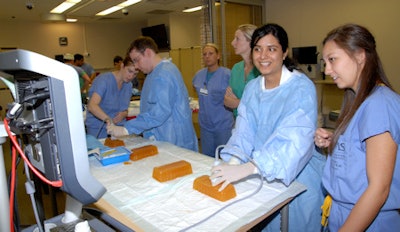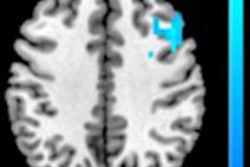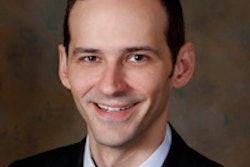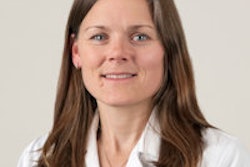
When the directors of an Arkansas residency program saw their interns having a hard time transitioning to their second-year radiology residency, they decided to do something about it, according to a report published online September 3 in the Journal of the American College of Radiology.
The result was residency boot camp, a one-month orientation that combines didactic learning with hands-on practice and team-building to turn clinical interns into residents. Now, with the second year of camp under their belts, Dr. Kedar Jambhekar and colleagues are feeling confident enough to call the program a success.
"We learned that orientation is helpful, and that we would like to keep going with it, making minor changes; but pretty much every one of [the residents] said it has been helpful," said Jambhekar, an associate professor of radiology at the University of Arkansas for Medical Sciences in Little Rock.
Sharp turns ahead
A radiology residency lasts five years, of course, but the first year, internship, usually has little to do with radiology.
"It's really about taking care of patients, which is very different from what they will eventually do as radiologists," explained co-author Linda Deloney, EdD, assistant professor of radiology at the Arkansas center. "They're supervised, but they do direct patient care in that intern year."
At some point during their intern year at the University of Arkansas, all radiology trainees get a two-month rotation in radiology, more than in some other institutions, Jambhekar said. But regardless of where new residents train, life can be challenging for first-year interns fresh out of medical school. And the path gets even steeper the following year when they transition to radiology residency and start facing a lot of new expectations, the authors wrote.
 Dr. Kedar Jambhekar from University of Arkansas for Medical Sciences.
Dr. Kedar Jambhekar from University of Arkansas for Medical Sciences.
"New interns struggle with a lack of medical knowledge, poor organizational skills, inadequate ability to reflect and self-assess, and underdeveloped professionalism, most often attributed to a lack of thorough preparation in medical school," they wrote (JACR, September 3, 2013).
After an intern year in clinical practice, or perhaps surgery, transitioning back to radiology presents new challenges.
"The radiology resident is no longer the primary contact in direct patient care and decision-making, but is expected to be an imaging consultant, operating largely behind the scenes in an unfamiliar specialty," the authors wrote. "Few residents gain skills and experiences with imaging modalities and studies during medical school and internship, so they find themselves as novices once again."
Radiology's reliance on the Internet and digital devices for accessing educational material requires a high level of technological expertise, and the volume and complexity of new information to be assimilated can be demoralizing, they added.
In most institutions, any bumps in the road are expected to be smoothed out by orientation, which all residency programs provide. But the Little Rock team wanted to create something more substantial to provide the eight new residents who enter the program each year with a more solid foundation. Thus, radiology boot camp was born.
Boot camp begins
"We thought if we could structure it in a way that in the first month they get to see a little bit of everything, they would really not be completely overwhelmed," Jambhekar told AuntMinnie.com.
Initially, the program consisted of full-day courses for two weeks. However, based on feedback, the boot camp was shifted to half-day courses for a month.
The program includes team-building workshops and didactic lectures, and campers spend time with technologists to see how x-ray exams are acquired and how the CT and MRI scanners work. Residents also perform some simulation training in the interventional lab.
"We also saw [boot camp] as an opportunity for them to come together as a cohesive group with some team-building and bonding, because they really have to rely on each other for the next four years," added Deloney.
In addition to trust exercises and other formal team-building activities, informal activities such as shared meals and bowling nights help residents bond and get to know each other, according to the authors.
 Residents practice ultrasound-guided vascular access using a homemade gelatin phantom. From right along the table: Dr. Megan Long, Dr. Gitanjali Bajaj, Dr. Steven Wright, and Dr. Mollie Meek (instructor). Image courtesy of the University of Arkansas for Medical Sciences.
Residents practice ultrasound-guided vascular access using a homemade gelatin phantom. From right along the table: Dr. Megan Long, Dr. Gitanjali Bajaj, Dr. Steven Wright, and Dr. Mollie Meek (instructor). Image courtesy of the University of Arkansas for Medical Sciences.Didactic lectures in the half-day courses cover things like how to read a CT scan of the abdomen, and what is normal anatomy in the region. "Very basic stuff," Jambhekar said. "And the other half of the day they spend in the reading room, sitting with the attending and reading scans -- doing real work."
Boot camp 2012 learning topics included the following:
- Medical knowledge: 30 basic lectures with an emphasis on emergency radiology; introduction to NEOnline authorized user course
- Interpersonal skills: get-acquainted "ice-breaker" lunches; social activities, e.g., bowling
- Professionalism: introduction to professional societies; evaluation processes; dealing with fatigue and burnout
- Systems-based practice: orientation and credentialing; passwords; HIS/RIS training; HIPAA
- Research: introduction to research
"We also use the time to do a lot of the housekeeping things that need to be done: getting them logged on to all the various computer systems, getting their passwords, getting their ID badges," Deloney said.
Evaluating the trainers
The directors distributed evaluation forms throughout the course to monitor quality and open the program up to new ideas, soliciting feedback about every lecture so that suggestions could be implemented in real-time. Self-perceptions are also important, so the group used checklists to monitor residents' perceptions of their own clinical competence before and after the boot camp, the authors reported.
Finally, entrance and exit surveys were conducted to evaluate residents' confidence and awareness of their roles and responsibilities. The survey was repeated six months after the boot camp to assess the sustainability of the learning.
"Although the size of our population was small, and residents' perceptions are known to be highly subjective, all participants consistently reported that the experience increased their confidence and knowledge of expectations for the upcoming residency," the study team reported.
 Linda Deloney, EdD, assistant professor of radiology.
Linda Deloney, EdD, assistant professor of radiology.
For example, the residents reported better understanding of conference attendance and call and more confidence in their ability to use radiology systems such as PACS and voice recognition. The improvements were sustained over a six-month period, the authors wrote.
Refinements
The evaluation data are being used to restructure the program, where needed. Some of the boot-camp programs have been too detailed, and that will change, Jambhekar said.
Discussion of departmental and program policies will be limited to one topic a day. More time to complete quality improvement online modules and online human subjects training has been included in the curriculum. Simulation workshops were deferred until this fall to provide residents with more time to prepare using didactics and work experience, the study team wrote.
"They always give us really good feedback as to what can be changed, and the biggest change is that last year we did it as a whole-day course for two weeks, and it got really tiring for them," Jambhekar said. "That's why this year we changed to do it for a month but only half a day."
Another complaint was that the PubMed search session was too long and detailed -- it has since been pared down, Jambhekar said.
Overall, the learning experience appears to be solid, but it has not been validated over the long term, he cautioned. In addition, the schedule only allowed residents to skim the surface of radiology, and there wasn't enough time for lengthy discussions on physics, professionalism, or other complex topics. Some residents reported fatigue, but on the positive side there were no clinical work distractions during the learning sessions, the authors stated.
In general, the experience decreased anxiety regarding rotations, increased awareness of roles within the department, and fostered the development of team spirit and camaraderie, the group concluded. Perhaps best of all, the boot camp allows radiology teaching to be targeted to the new residents' training level, they said.
"We don't expect them to remember everything; our goal was for them to have heard these terms before, and not say, 'Oh, I've never heard this,' " Jambhekar said.



















